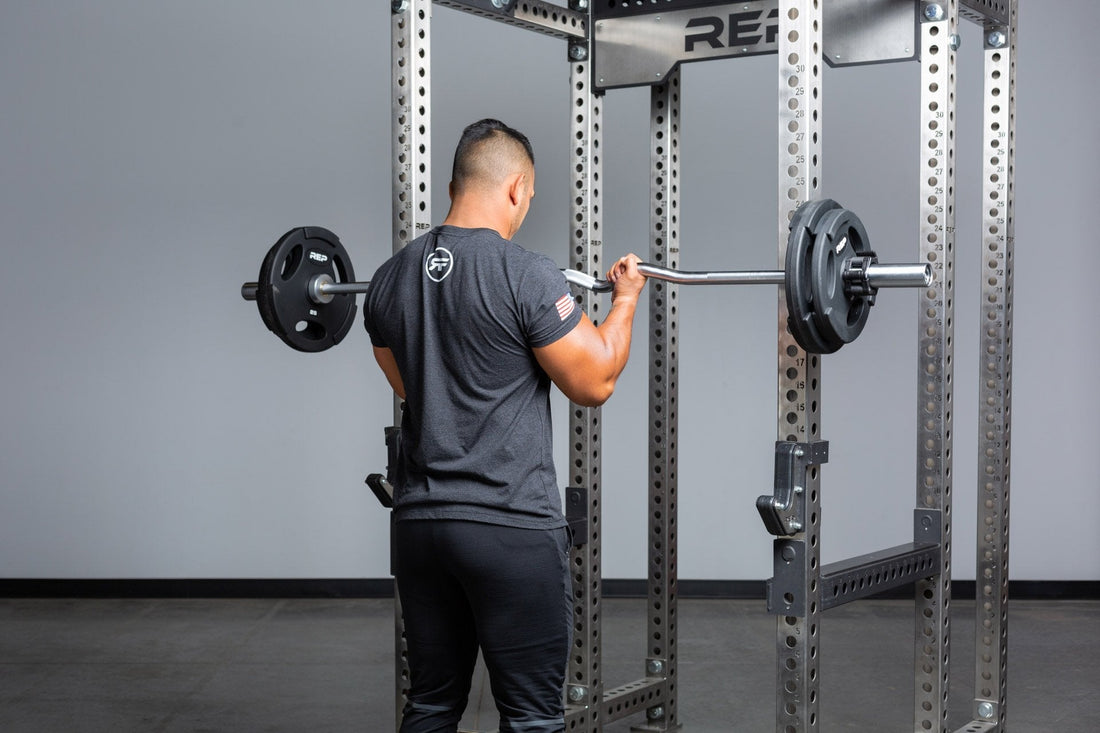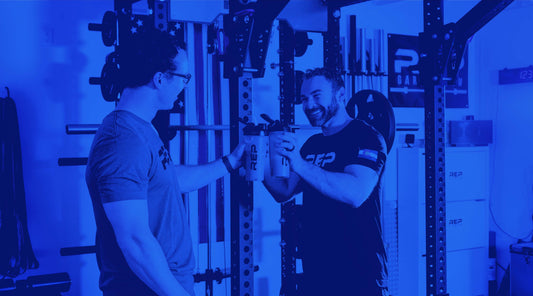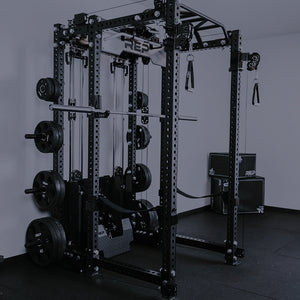
The trick for a better pump.
Looking out across a packed gym, the verdict is clear: like the ants that keep sneaking into my kitchen, barbell curls are everywhere. And honestly, who doesn’t want bigger, stronger biceps? They pair well with tank tops, t-shirts, dresses — you name it. The bicep is like the color black: it goes well with everything.
Beyond flexing in the mirror and whispering “hot diggity” under your breath, this move also plays a meaningful role in overall upper-body strength. “The barbell bicep curl is an accessory exercise [that] supports the strength and performance of larger movements like rows and pulldowns,” says Nicolette Amarillas, strength coach, posture specialist, and founder of Nicolette A. Wellness.
Barbell curls primarily target three muscles: the long and short heads of the biceps brachii muscle, which takes up the front of the upper arm; the brachialis, which supports elbow flexion; and the brachioradialis, which runs from the bicep into the forearm. You’ll also get some bonus activation in your forearm and wrist flexors and extensors, along with a sprinkle of engagement for your anterior delts.
How to Do Barbell Curls The Right Way
A step-by-step guide to proper barbell curl form and technique.
- Set up: Stand tall with your feet about shoulder width apart. Grab a barbell with a supinated (also known as underhand) grip, shoulder-width apart. Keep a soft bend in your knees and elbows.
- Full-body engagement: With a tight grip on the bar, squeeze your glutes, engage your core, and pull your shoulder blades together slightly.
- Curl up: Keep your elbows tucked by your sides while you curl the bar up toward your shoulders. Maintain that tall posture without swinging.
- Squeeze at the top: Pause at the top and squeeze your biceps.
- Control down: Maintaining tension throughout your body, slowly lower the bar back to start.
Common Curl Mistakes
As you’re learning how to do proper barbell curls, keep your eyes peeled for these common form f**k ups.
Swinging the weight: Sure, using momentum is going to allow you to move more weight, but doing so ends up using various muscles throughout the body, limiting the dialed in attention on your biceps. Instead, curl the weight up and lower with control.
Locked out elbow: At the bottom of the curl, avoid locking out your elbows because that can cause pain and discomfort for your joints. Instead, keep a slight bend to your elbows at the bottom of your curl.
No upper back engagement: “While curls primarily target the biceps, optimal activation of the biceps requires proper shoulder positioning, which is supported by engaging the scapular stabilizers,” says Amarillas. “Engagement of muscles like the rhomboids, mid traps, and lower traps help maintain a strong, upright posture and help prevent the shoulders from collapsing forward, ultimately improving biceps recruitment and movement efficiency.” AKA, Make a mind-muscle connection and engage your back with each rep.
Barbell Curl Variations
We’ve covered the standing barbell curl benefits and form — now play around with these variations to find the right move to add to your routine.
Supinated EZ-bar curls
If you have some wrist or elbow discomfort when performing barbell curls, using an EZ-bar or the REP Curl Bar — you know, the ones that look all squiggly wiggly — can help place your arms in a more ergonomic position to reduce stress and strain. And don't worry, "supinated" is just fancy talk for an underhand grip, so this move basically stays the same — you'll just be using a squiggly bar instead of a straight bar.
Barbell wrist curl
This move targets your forearm, grip strength, and wrist stability — ideal for weightlifters looking to tackle a PR, athletes like rock climbers and tennis players, and anybody who’s ever struggled to open a jar of pasta sauce. In a seated position, rest your forearms on your thighs with an underhand grip on a barbell that’s positioned just beyond your knees. Allow the barbell to roll towards your fingertips as you flex your wrists, then curl the bar back in by extending your wrists.
Reverse barbell curl
Follow the same movement pattern as a standard barbell curl, but flip your hands so you’re set up with an overhand grip — a "pronated grip" if you're trying to impress your friends. This hand swap continues to target your biceps and brachialis, but provides more of a focus on your forearms and grip strength.
Seated barbell curl
In a standard barbell curl, you’re typically stronger during the second half of the movement — when the weight moves closer to your shoulders — because that's when the biceps really kick in. To help target the bicep without being limited by weaker muscles fatiguing, the seated barbell curl cuts the movement in half so you’re only doing that top half of the lift. Sit tall on a bench and rest the bar on your lap. With an underhand grip, curl the weight up, then lower it, making sure to keep your elbows back throughout your rep.
Preacher curls
While the barbell curl move gets a little support from the rest of your body, a preacher curl takes away that support and totally isolates your bicep. Using a preacher bench or pad to rest your arms, this move prevents momentum, forcing strict form and isolated muscle activation. Because you can't use momentum here, you'll probably want to start lighter than your usual barbell curl.
Try It: Barbell Curls Workout Programming
“While valuable for upper body development, [the barbell curl] typically won’t be the heaviest or most demanding lift in your session,” says Amarillas. “That’s why I program curls toward the end of a workout, after the major compound lifts are complete. This prevents the biceps from fatiguing too early and impacting performance in bigger movements.”
In other words, complete the meat of your workout while you’re fresh, and toss in some curls at the end to round things out.
“Since it’s an accessory, I generally keep the rep range at 8 or above,” Amarillas adds. “Sets of 8-12 are ideal for building strength and hypertrophy, while higher reps can increase muscular endurance depending on the training goal.”
We don’t advise working in the 1-5 rep range for barbell curls like you would when training for strength with a compound lift. Since it’s a single-joint isolation move, going too heavy can place unnecessary stress on your joints or cause your form to break down.
While recovery looks different for everyone, we also recommend giving yourself 48 to 72 hours between sessions using this move. So aim for adding it to your routine about twice, maybe 3 times, a week.
And remember, when choosing how many plates to add on, consider the curl bar weight which can range from as little as 10 pounds (4.5 kilograms) up to 45 pounds (20 kilograms).
Barbell Curls vs. Dumbbell Curls
Barbell curls and dumbbell curls can both get the job done when it comes to building bigger biceps — but while they may look similar, they’re not totally interchangeable.
“Barbell curls are great for standing variations that require more core engagement and full-body stabilization,” says Amarillas. You can typically lift heavier — ideal for progressive overload — since both arms are working together to move the bar. But because of that shared load, one side might do more of the work without you realizing it. Think of it like a group project where you don’t even notice the funny kid hasn’t done jack squat.
Without picking a favorite, Amarillas notes that dumbbells offer greater flexibility in how you train. “You can perform them seated, on an incline bench, alternating, or with different grip positions,” she says. “They’re also useful for identifying side-to-side imbalances.”
There’s room for both moves in your routine, especially if you’re serious about building some peaks. “Variety plays a powerful role in keeping training engaging and well-rounded,” she adds.
Takeaway
Whether you’re looking to sculpt the kind of arms that people like to ogle or want to support your other lifts — like rows, pull-downs, deadlifts, and carries — tossing barbell curls into your workout can give you the assist. It’s a simple accessory move, but when done with proper form (elbows tucked, core engaged, no swinging) and consistent effort, it can deliver some serious strength… and maybe even a few double takes.
FAQs
Can beginners do barbell curls?
Yes! This move is great for beginners. It’s one of the simplest moves to master — it isn’t a complex or compound lift that requires the choreography of multiple joints and muscles to move — and doesn’t need a ton of equipment to tackle.
How much weight should I start with?
When learning a new move, it’s always best to start light and work your way up once you’ve nailed down the form. You’ll also want to take note of the weight of the bar that you’re using, and consider starting off using just the bar.
Should I use an EZ-bar or straight bar?
The choice of which bar to use depends on preference, goals, and what feels right for you. The EZ-bar is great for people who experience wrist or elbow discomfort when using a straight bar. But a straight bar is ideal for individuals looking to load up more weight. For those new to weight lifting, we’d recommend using an EZ-bar.
What do barbell curls and dips have in common?
While the barbell curl is a pull that targets the bicep, and a dip is a push that primarily targets the triceps, they’re both accessory moves that are used to isolate muscles of the upper arm. They’re also an ideal pairing to maintain muscle symmetry.
Rosie Borchert is NASM-CPT, former Nike Volleyball coach, and fitness writer whose work has appeared on BarBend and Tonal. If anyone would like to hire her to play beach volleyball, snowboard, binge watch TV, or go climbing, please get in touch.
This article was reviewed by Ashley Boyer, ACE-CPT, for accuracy.

NEWSLETTER SIGNUP
Product launch information, promotions, blogs, and REP news.







